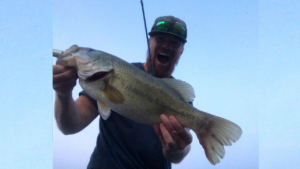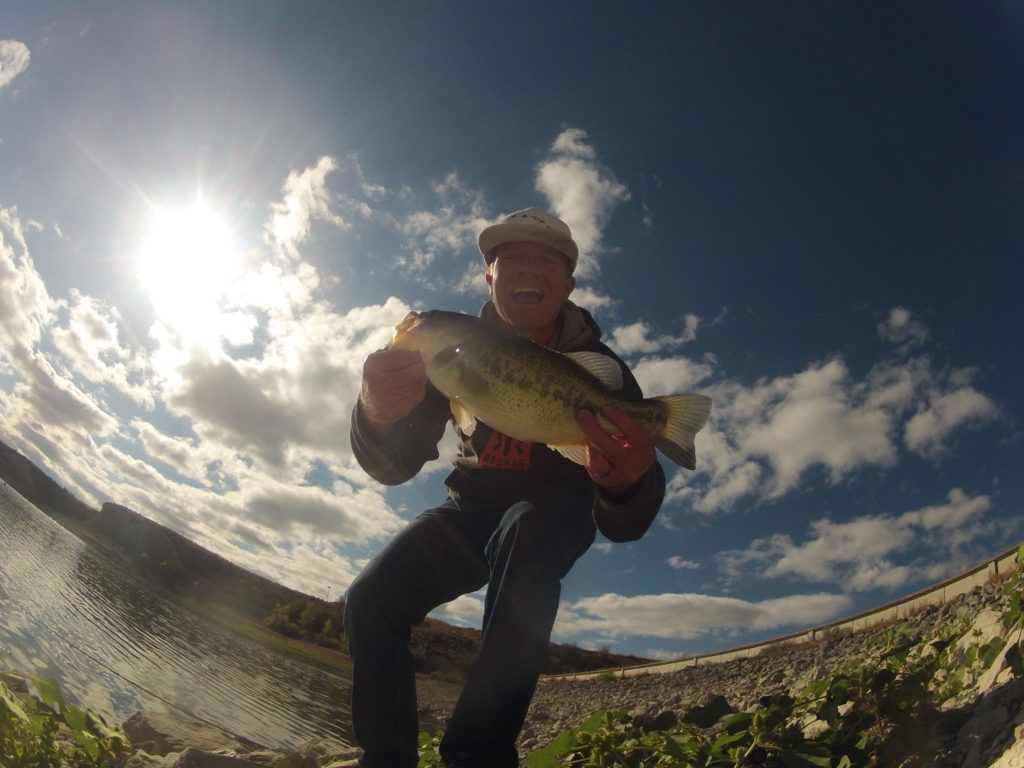

Cranking a soft plastic for bass can be a great technique in the late fall. I’ve had a lot of success with it recently this time of year. This technique is often referred to as “biffle bugging,” named after the bass fishing pro who made this technique popular. Here are the logistics of everything you need to know about cranking soft plastics for bass. Hopefully, it can help you get a few more bites when you are out on the water this time of year.
Slowly winding a soft plastic along the bottom, so it ticks and bounces off cover can elicits some sweet strikes from bass. Most people think of fishing soft plastics by slowly hoping or crawling them along the bottom. They are missing out on a great way to catch bass. Cranking soft plastics, commonly known as “biffle bugging,” elicits a reaction strike from bass. When cranking a soft plastic it will often bounce off or spring free of cover and whiz by the fish. As the bait whizzes by, bass can’t help but smack it. It is instinctual for a bass to bite when something is trying to flee away. It’s a natural reaction bass see from baitfish and other prey when they swim up to eat them in their environment.
This reaction strike is sometimes the best way to get bites when the water temperatures cool off. Plus, it also works great to cover water until you find some fish. Then once you find fish you can slow down and milk them out. I’ve always used the traditional biffle bug set up when cranking soft plastics. Here is everything you need to get set up for fishing this way.
The majority of the time a medium heavy extra fast tip rod with a dependable baitcasting reel is the way to go when biffle bugging. You need something with some back bone and some give. The give in the rod will let the bass eat the bait, and then the backbone of the rod will help drive the hook home in the bass’s mouth as you are winding it along. I spool the reel up with 10 – 12 pound fluorocarbon fishing line
. I try to get away with as light a line as possible. I feel like it helps get more bites.
There are a variety of swinging jig heads out there, and a ton of soft plastics you can use for this technique. My favorite is the traditional biffle bug with the hard head swinging jig. The biffle bug has great kicking action, and the hard head jig really bounces off the cover. The key is to make sure you match the right weight with the depth of the water you are fishing. The deeper you want to bounce your bug along, the heavier weight you want. The opposite is true as well. If you are only fishing 2 – 3 feet you want to go with a lighter weight on your jig head. Here are some more logistics on all the items you’ll need to start biffle bugging.
The 7′ 2″ Medium/Heavy Abu Garcia Vendetta is the rod I’ve used. It works great for this technique. It has some give in the tip, and some back bone so you can get those big bass in you catch biffle bugging.
There are a lot of good bait casting reels on the market. This is the one area I don’t like to go cheap on. A good reel can help you cast further and more accurately. One of my favorites that I use is the Lews Tournament Speed Spool. It’s super smooth, and works great for cranking soft plastics. It’s definitely a high end reel that is priced better than a lot of other brands. I absolutely love mine.
There are so many soft plastic crayfish on the market it’s ridiculous. For cranking soft plastics I like to go with the orginal gene larew biffle bug. It’s bulky to get big bites, and it has tons of good looking appendages to elicit strikes when cranking soft plastics. My go to color is green pumpkin. It’s the only color you’ll ever need in this bait. You can even stuff the hollow body with scent to try and get a few more bites. It’s a great bait to get the job done.
There used to not be so many swinging heads on the market as there is now. You might want to play around with a few, but I’ve found theoriginal gene larew hard head jig is hard to beat. It has an excellent wide gaped 3/0 hook that fits perfectly on a biffle bug. I’ve yet to have a bite where I haven’t hooked up and landed the bass on this jig head. Select the appropriate weight for what depth you’ll be fishing and go to town. I primarily use the 5/16 oz head, but there have been several times where I could’ve used the lighter 3/16 oz head. Here are some rules of thumb get an idea of what weight to use at different depths for this technique.
0-5 feet: 3/16 oz hard head jig
5-10 feet: 5/16 oz hard head jig
10 – 15 feet: 7/16 oz hard head jig
15 – 20 feet : 11/16 oz hard head jig
Cranking a soft plastic is really quite simple. All you do is throw out your bait, and let it settle to the bottom. Once your bait is on the bottom you slowly start reeling it in. You want to make sure your bait is bumping and banging along the rocks and cover as you are bringing it in. You may have to speed up or slow down your retrieve depending on the weight you are using to keep it grinding.
One thing I’ve found is if you are fishing really craggy rip rap, these baits can get lodged in the rocks fairly easily. The key to make sure you don’t hang up is to try and make your bait bounce off the tops of the rocks. You need to a reel a little faster than normal, so you occasionally are feeling ticks and bumps from the bottom. You also need to make sure you check your line frequently. With all the banging and grinding your line can get beat up. Re-tie every so often, so you don’t lose that big bass when he bites.
The key to making this technique work is having the bait spring free off the rocks or cover you are fishing. This is when I’ve gotten all my strikes. It’s intense. It feels like you are hung up then all of a sudden there is a bass on the end of the line. The other thing I like about this technique is it seems to catch better than average sized bass. Here are some picture of chunks I’ve caught while biffle bugging:
Hopefully, this gets you stoked to try some biffle bugging and cranking those soft plastics. I’d love to hear some of your suggestions or tricks you’ve found fishing this way if you have in the comments below. Don’t forget to subscribe to the blog to get notified of posts like this to help expand your tools. Now go out and “Krak” some bass! Don’t be afraid to reach out to me if you have any questions.
As Always,
Stay Stoked!!
The links above and below in this post are affiliate links were you can pick up baits, rod’s, reels, line, and anything else I used to “Krak” some bass with this technique. Krakenbass receives a small percentage of the sales through these links. I only use links to baits, and gear I have personally trust and know work. I put these links to make them helpful for you, and not for the small amount I make for the sale of the products. I hope these products can help you “krak” some bass! Thank you for your support.
You need a system to know where to go, what to use and how to work your lures to catch more bass in every situation.
Use this lure color selection chart and perfectly match the color of your lure to what bass are wired to eat without trial and error so you can catch the monsters!
Discover how to perfectly match the color of your lure to what bass are wired to eat so you can catch the monsters!
4 Responses
I’ve never done it with a swinging head, but I know a 3/4 oz jig and big trailer works well in 20-30′ for smallmouth.
What type of jig do you like to use? That sounds like something I should try for sure!